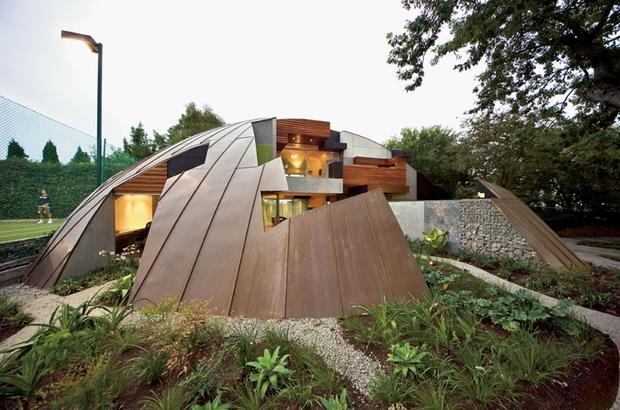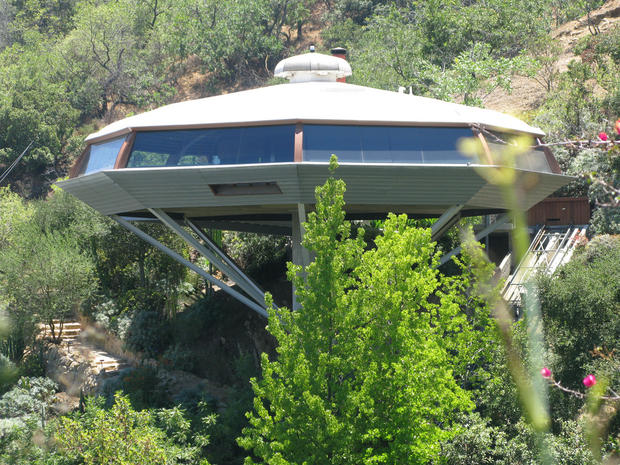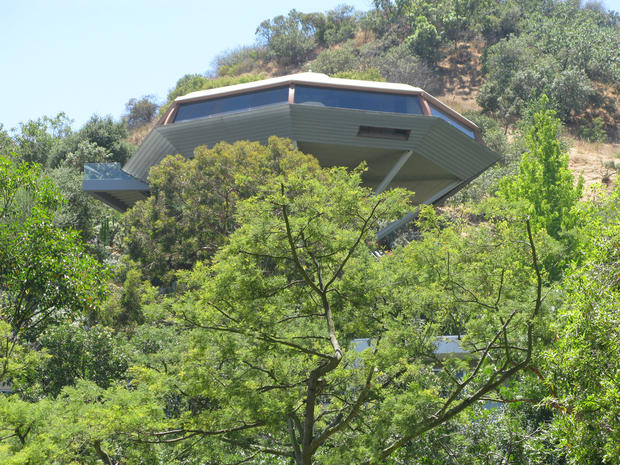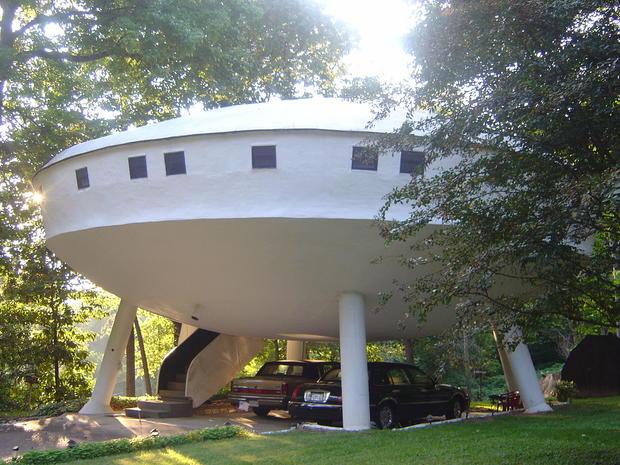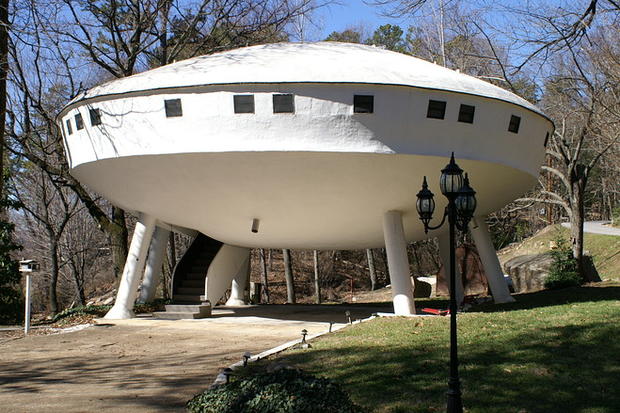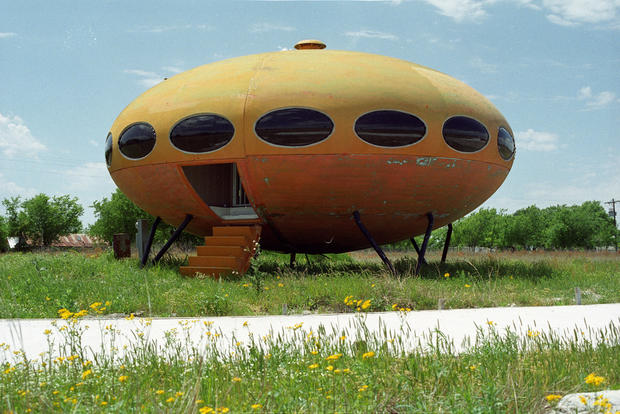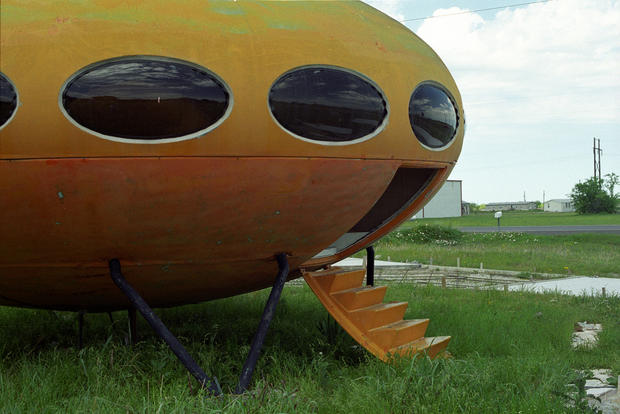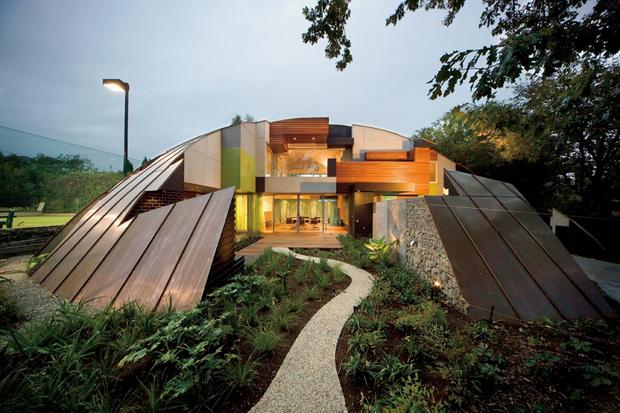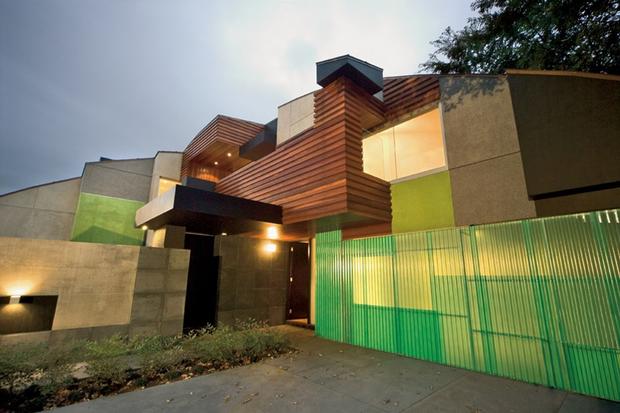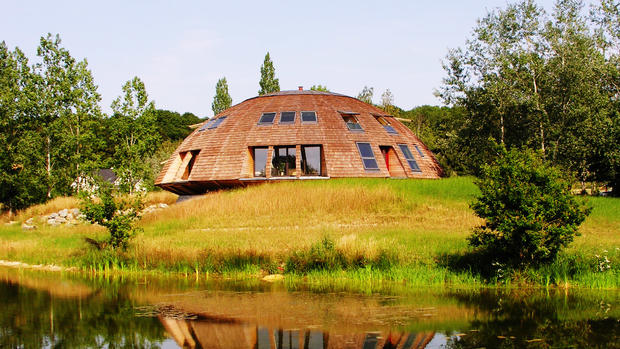Homes that may secretly be spaceships
Photo by John Gollings, courtesy of McBride Charles Ryan
The next time you see an alien spacecraft seemingly perched on a hill or out in the middle of the field, look again. It may be a home.
Spaceship-shaped homes first gained popularity during the 1960s, but they've experienced a revival in the last decade. A few years ago, Russian billionaire Vladislav Doronin built an extravagant, otherworldly home for model Naomi Campbell that featured a sleek, white, multilevel exterior, luxurious amenities (like a massage area and spa) and views of the nearby birch forest.
In 2005, Australian architecture firm McBride Charles Ryan built a garden home with environmentally friendly components (like a rainwater collection system and double-glazed windows) that could pass for a submerged, copper tribute to Star Trek's Enterprise.
For homes that look like they could exist in space, many saucer-like properties are designed to encourage owners to embrace the outdoors on Earth.
French designer Patrick Marsilli's Dome Spaces, which were originally conceived in the late '80s, are still being built with a mechanical rotation system that turns the entire home toward the best sunlight throughout the day and is made from materials certified by the Forest Stewardship Council.
Finnish architect Matti Suuronen's "Futuro" homes were originally conceived as modern, portable ski lodges that could heat up quickly to relieve people from the cold after hitting the slopes.
Check out these seven spaceship-like homes before they fly away.
Malin House (Chemosphere) – Los Angeles
Photo courtesy of Flickr user Squid Ink
According to architect John Lautner, the Encyclopedia Britannica once named his Hollywood Hills "Chemosphere" house "the most modern home built in the world." Since 1960, when it was built for Los Angeles aerospace engineer Leonard Malin, plenty of flying-saucer-looking, modernist contemporaries have popped up to challenge the property's moniker, but its notable role in architectural history remains intact. It has also gotten some pop culture acclaim, appearing in the films "Body Double" and "Charlie's Angels."
Malin House (Chemosphere) – Los Angeles
Photo courtesy of Flickr userSquid Ink
The famed octagonal home, which has 2,200 square feet of space and sits at the top of a 29-foot-high, 5-foot-wide concrete column, is built into a steep, 45-degree lot that challenged Lautner to create its unique structure. The whole project originally cost $30,000 -- an astonishingly low price even for its time -- because of the architects' innovative design as well as the sponsorships of companies like Chem Seal, which was rewarded with naming rights, according to the Los Angeles Conservancy.
Malin and his wife raised four children in the home. Since then, it has gotten new owners who renovated the property with the help of architect Frank Escher. They removed layers of paint, repaneled the walls with ash wood and replaced the windows with frameless glass.
Capital Hill Residence – Moscow, Russia
Photo courtesy of Zaha Hadid Architects
This Barvikha home just outside Moscow looks as though it could have been partially inspired by a "Star Wars" freighter. Located on a scenic hillside, the vertically designed, four-story villa was commissioned in 2006 by notorious Russian billionaire Vladislav Doronin for this then-girlfriend Naomi Campbell. The couple has since parted ways, but the futuristic abode is still standing.
Capital Hill Residence – Moscow, Russia
Photo courtesy of Zaha Hadid Architects
Created by architect Zaha Hadid and finished in 2011, the property features two main parts: One is built directly into the sloping landscape, and the other is elevated about 72 feet above the ground by concrete columns. It features many ultra-lux amenities like a massage and fitness area, saunas, an indoor swimming room, library, large dining area, ultramodern-looking fireplaces, floating stairwells and floor-to-ceiling views of the surrounding birch forest.
“The Spaceship” – Guilford, Connecticut
Photo courtesy of Zillow
When architect Wilfred Armster was asked to design a condo building on the former site of a Guilford, Connecticut, restaurant in 1984, the locals weren't expecting something that looked like a copper space station. When this 13-condo complex was finished (in all its round, industrial-yet-rustic glory) one person even threatened to kill him.
"I'm probably a socialist -- a capitalistic socialist," Armster told the local New Haven Register at the time. "I really thought a building like this would bring people together. That's not true."
“The Spaceship” – Guilford, Connecticut
Photo courtesy of Zillow
The 300-foot-long, controversial property has one unit currently on the market, according to Zillow. It has one bedroom, two bathrooms and 1,448 square feet of space. It features hardwood flooring, a fireplace, walk-in closet and access to one parking space.
Flying Saucer House – Signal Mountain, Tennessee
Photo courtesy of Wikimedia Commons user Heavybluesman
Instead of a front door, the "Flying Saucer House" in Signal Mountain, Tennessee, (about 140 miles southeast of Nashville) has a staircase leading up from the ground. Instead of a traditional bedroom, the home has a room located in one of its central columns that looks more like a sleeping pod.
Flying Saucer House – Signal Mountain, Tennessee
Photo courtesy of Crye-Leike Real Estate Services
It was built and designed by Curtis King for his son in 1973, complete with a control board that originally could raise and lower the entry stairs. The white steel and concrete building, with a saucer-like body perched atop four columns, cost $250,000 to build. It features about 2,000 square feet of space, three bedrooms, two bathrooms, a bathroom with stairs leading to a birdbath-looking tub and modern, circular lighting that looks ready for takeoff.
The home has changed owners since then, most recently being sold at auction for $120,000 in 2008. It's currently for rent to vacationers.
Futuro House – Royse City, Texas
Photo courtesy of Flickr user Steve Rainwater
Finnish architect Matti Suuronen designed what became a series of prefabricated "Futuro" homes in 1968. He intended for them to be a modern and portable ski retreat, according to Slate, but instead the fiberglass, polyester-plastic and metal structures were marketed and sold internationally as a way to live in any type of environment with any climate. They feature a quick heating system, one bedroom, one bathroom, a fireplace, kitchen and a living area.
Futuro House – Royse City, Texas
Photo courtesy of Flickr userSteve Rainwater
Fewer than 100 of the now-iconic saucer structures were ever built. Production stopped during the oil crisis of the early 1970s, when materials became too expensive. Some are abandoned and falling into disrepair, like this model located in Royse City, Texas, about 32 miles northeast of Dallas. Others have been restored, like the unit located at the University of Canberra in Australia, which is used as a study space.
Dome House – Hawthorn, Australia
Photo by John Gollings, courtesy of McBride Charles Ryan
The "Dome House," designed by architecture firm McBride Charles Ryan, may look like a spaceship, but its structure is planted firmly on the ground, surrounded by a garden.
The approximately 4,300-square-foot home, located in a suburb of Melbourne, Australia, was inspired by the idea of a puzzle, according to the firm, with large and small pieces eroding the copper sphere in the center. It was built for a single artist with lots of frequently visiting family members, so the firm created adaptable spaces that accommodate guests.
Dome House – Hawthorn, Australia
Photo by John Gollings, courtesy of McBride Charles Ryan
Dome House has environmentally friendly features, like rainwater collection, solar hot water and drip garden watering systems, according to Inhabitat. Double-glazed, energy-saving windows also provide lots of natural light.
Dome Spaces
Photo courtesy of Solaleya
This line of dome spaces, built by the Florida-based company Solaleya, are so aerodynamic they look alien. But despite their otherworldly appearance, they could be a good option for environmentally conscious earthlings.
Originally created by French designer Patrick Marsilli in 1988, the dome units come in three models with many customization options. The smaller "Transit" model ranges from 420 to 527 square feet and can be used for guest rooms or lounge areas, according to Soleleya. All models feature red cedar roofs, cork insulation and lots of skylights.
As of 2008, most dome spaces cost around $160 per square foot (not including land) to build, according to clean energy blog Green Tech Media.
Dome Spaces
Photo courtesy of Solaleya
The eco-friendly saucers are built entirely of chemical-free wood certified by the Forest Stewardship Council. The "Harmonique" model even rotates on a mechanized concrete pedestal toward the best sunlight. All three models are designed to withstand harsh weather conditions, including hurricanes and earthquakes.
